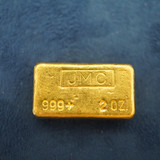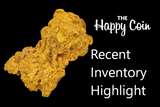Gold Fever
The folklore of the California Gold Rush is so ubiquitous and deeply embedded in our popular culture, even today, that it almost goes unnoticed. Who hasn’t heard of the NFL’s 49ers, but how many know that the nearly 300,000 prospectors who flocked to the area were first referred to as Argonauts? Or, that the strike, made at Sutter’s Mill in Coloma, California by a man named James Marshall, brought financial ruin to John Sutter who aspired to create a timber and ranching empire before he was overrun by the rush? Or, that this discovery of gold in January, 1848 catalyzed California statehood, the founding of the San Francisco Mint, and an important type of privately minted coins?
Vast amounts of gold were mined in the early days of the rush. While some of the extracted gold was used in dust form as local currency, a somewhat urgent need arose for the assaying, smelting, and the production of coins.
Before the San Francisco Mint was opened in 1854, private minting companies appeared to transform the gold into coins, ingots, and bars. Federal law at the time precluded the states themselves from issuing currency and coins, but it did allow for privately issued coins with the proviso that they should not resemble federal coins too closely. This is perhaps one reason why many of the coins produced in private mints of the era were octagonal in shape.
Until the Coinage Act of 1864 made private production of coins illegal, several private minting companies flourished. During the California gold rush, as many as 15 private mints were converting gold into coins. Three of these were regarded above all others: Moffat and Co., Kellog and Co., and Wass, Molitor and Co. Public trust in these was engendered by a few key attributes: mineral fineness, weight and artistry. For example, an 1852 $5 Gold coin from Wass, Molitor and Co. had a gold fineness of .880 and a weight of 131.9 grains while the US $5 coin of the day carried a standard fineness of .900 and weighed 127 grains. The extra weight of the Wass, Molitor coin more than compensated for its deficiency in gold content relative the US coin.
It is Moffat and Co. which had the most durable impact on gold rush coinage. John Little Moffat was a veteran of the Carolina/Georgia gold rush and at age 61 lit out for California territory from his home state of New York. In California, he and three partners founded an enterprise to meet the demands of the rush. Moffat and Co. began operations by assaying and smelting gold into ingots and bars.
The company’s coin production began when it hired George Albrecht Ferdinand Kuner. He was a German émigré and engraver living in New York City, when, as he put it in a reminiscence he wrote in 1904, “California fever broke out.” Kuner almost immediately embarked on the voyage to California, intent on being a prospector. On a chance stroll through the streets of San Francisco, he found a job as an engraver at Moffat and Co. His first work for Moffat produced a $10 coin and then a subsequent $5 coin.
Moffat and Co. produced coins for about two years. Its reputation was bolstered by its standing offer to redeem the face value of any of its coins in silver. At the time, there was widespread distrust of private coinage and there were many calls in the state legislature to protect the public from unscrupulous minters.
California became a state in 1850 and was admitted to the Unites States on September 9, the day is still celebrated as Admission Day. As statehood took hold and the rush matured, the advent of a local US Mint became a foregone conclusion. By an act of Congress and signed into law by Millard Fillmore in 1852, the San Francisco Mint was born. It began operations on April 15, 1854. The irony of its choice of start date does not go unnoticed.
John Moffat sold his interest in his eponymous firm to his three partners and tried his hand at mining. The firm he founded survived for a few more years and then in 1854, its assets and operations were turned over the San Francisco Mint.
Recent Posts
-
The Happy Coin's Winter Holiday Sale - 10% off select eBay items!
Happy Holidays! The Happy Coin's Winter Holiday Sale is back! For the 2025 holiday season, nearly a …Nov 27th 2025 -
The Incredible Value Density of Gold
A zoomed-in picture of a 2 troy ounce .999+ gold bar. A picture of a 100 troy ounce .999+ silver …Nov 21st 2025 -
Discover Our Prized 243-Gram 23K Gold Nugget
Gold coins and handmade jewelry can often highlight skillfull craftsmanship and the exquisite beauty …Aug 29th 2025




